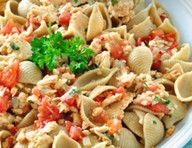Updates to the TEFAP Foods Available List
The Foods Available List for the Emergency Food Assistance Program (TEFAP) was updated to reflect recent changes including new foods, material code changes, and items removed due to supply chain related product shortfalls. Check out the new Kosher certified items highlighted below!
Kosher Certified Items
The TEFAP Foods Available List offers three new items that are commercial Kosher certified. Commercial certifications are administered by large supervisory agencies such as the Organized Kashrut Laboratories (OK) or the Orthodox Union (OU) and provided to manufacturers when their foods meet specific certification requirements. USDA accepts six Kosher certification symbols. For a list of Kosher certifications accepted by USDA, see Exhibit 8.1 in the Commodity Specification for canned vegetables.
Below is a list of the three new items that are required to have a commercial kosher certification and are identified on the FAL with a (K) next to the material description.
- Vegetables
- 100306 – Beans, Green, Low-Sodium, Canned (K) – 24/15.5oz
- 100311 – Corn, Whole Kernel, No Salt Added, Canned (K) – 24/15.5oz
- Fruit
- 100223 – Pears, Extra Light Syrup, Canned (K) - 24/15.5oz can

TEFAP Fast Track Survey
Thank you to the 309 TEFAP State and eligible recipient agencies who responded to the TEFAP fast track survey. The survey sought feedback on the foods currently available as entitlement offerings through TEFAP and included questions about culturally relevant foods and kosher and halal needs. The information received will help USDA FNS better meet the needs of charitable food organizations, families, and individuals.
|

Continuing Efforts to Support Kosher- and Halal-Observant Communities Through TEFAP
USDA FNS is continuing efforts to support kosher- and halal-observant communities served through the TEFAP program. Updates to the FAL include a requirement for all canned green beans (100306), canned whole kernel corn (100311), and canned pears (100223) to be certified kosher. In collaboration with advocacy organizations and other stakeholders, USDA plans to release tools and resources to educate and raise awareness about the dietary needs of kosher- and halal-observant communities. Keep an eye out for an upcoming webinar and new handouts that will focus on enhancing and improving cultural competency regarding kosher- and halal-observant dietary laws, including how to properly identify, store, and distribute these foods.
|

Using Community Data to Best Serve Clients' Cultural Needs
In August 2020, the Food Bank of the Rockies launched the Culturally Responsive Food Initiative (CRFI), which aims to overcome barriers of access experienced by Food Bank clients from different cultural backgrounds. Those barriers include: diverse food preferences, experiencing language barriers or uncertainty about eligibility, and not feeling comfortable when visiting food pantries that do not understand their culture.
In CRFI’s pilot phase, which concluded in May 2021 and involved eight counties, demographic information and feedback on food preferences was collected from more than 700 clients, 111 partners, and 12 cultural community organizations. Using that data, Food Bank of the Rockies developed food lists based on the preferences of the seven most prevalent cultures in their service areas (Eastern Shoshone, Ethiopian, Hispanic, Northern Arapaho, Russian, Somali, Vietnamese). Food Bank of the Rockies also launched 10 culturally specific mobile pantries, increased the average availability of the top 15 culturally responsive foods by 80%.
Gloria Vasquez, the government programs director at the Food Bank of the Rockies, says to keep in mind the different populations and cultures that you are serving and get to know what they are used to seeing on their table. Then, you can meet the clients where they are. For example, Food Bank of the Rockies serves a large Latinx population. While TEFAP doesn’t provide certain culturally specific foods like jalapenos or masa flour, there are available options like pork and diced tomatoes that are commonly used in Latinx recipes, so these items can help supplement a meal. Data also showed that clients are looking for frozen items and produce. All of this is taken into consideration when the Food Bank of the Rockies makes their ordering plans for TEFAP and CSFP so that they can best serve their clients' cultural needs.
To learn more about Food Bank of the Rockies' Culturally Responsive Food Initiative, take a look at their website.
|

So Many Seafood Options in TEFAP!
Pollock Fillets - 110345
Atlantic Pollock fillets are members of the cod family who are distinguished by their brown-greenish hue and dark flesh. They are found over hard, stony or rocky ocean bottoms in areas throughout the Gulf of Maine and Georges Bank. Pollock is nutrient-dense and one serving provides almost 40 percent of the daily requirement for protein. Pollock fillets are also a good source of vitamins and minerals that support a healthy lifestyle.
Here are some tasty recipes to try using Pollock fillets:
|

Canned Salmon - 110563 and 110580 (K)
Canned salmon is a nutritious choice that includes at least 40 percent of the recommended daily intake of protein. Because canned salmon includes skin and soft bones, it is a great source of Vitamin D and omega-3 fatty acids. This product is caught and processed in the United States and is certified kosher as well! Canned salmon can be a great quick and easy protein to add to any meal. Mix with pasta and veggies for a cold or warm lunch. Form into a patty and serve with brown rice. You can also try this recipe for Salmon Pasta Skillet!
|

Catfish Fillets - 110390
Catfish is a versatile, low calorie fish and a great source of lean protein. Catfish provides crucial nutrients such as vitamin B12, and omega-3 and omega-6 fatty acids. All USDA catfish products use commercial, U.S. farm-raised freshwater catfish, including channel catfish, blue catfish, white catfish and their hybrids.
Catfish can be prepared by baking, pan searing, or including it in a soup or stew for a hearty meal. MyPlate and SNAP-Ed have a number of recipes to try. Catfish can also be substituted for other fish fillets in your favorite recipe.
Here are some tasty recipes to try using Catfish fillets:
|

TEFAP Farm to Food Bank Update
On August 12, 2022, FNS published “TEFAP State Plan Requests and Allocations for FY 2023 Farm to Food Bank Projects”. This memorandum provided State agencies with information on how to apply for TEFAP Farm to Food Bank Projects in FY 2023. State Plan amendments were provided to FNS Regional Offices by September 16, 2022, and are under review. A summary of FY 2022 projects implemented by 29 state agencies can be found at this link.
|

CSFP 2023 Additional Caseload Requests
On September 23, 2022, FNS released the CSFP Submission of Additional Caseload Requests Memorandum for FY 2023 with information on the requirements for additional CSFP caseload requests for States and ITOs wishing to increase their assigned caseload in 2023. State agencies and ITOs requesting additional caseload for the 2023 caseload cycle (January 1 through December 31) must submit their State Plan amendments to FNS Regional Offices by November 5, 2022, in accordance with program regulations at 7 CFR 247.21. If State agencies or ITOs have questions regarding increasing CSFP caseload for FY 2023, please contact your Regional Office.
|
New Validation Tools and Notification in WBSCM
With the June and July releases, the Web-based Supply Chain Management (WBSCM) system introduced new validation processes to help users avoid data entry errors.
- While receipts are submitted, WBSCM will check the total receipted quantity against the expected shipment quantity from the Advanced Shipment Notification and the Purchase Order. If the amount entered is outside of the tolerance range (+/- 10 percent for most materials), users will be prompted to check their entry and try again or contact the WBSCM Service Desk for assistance if the out-of-tolerance quantity is accurate.
- WBSCM will only accept a goods receipt that has a total receipted quantity greater than zero; if the good quantity is zero, then rejected and/or damaged quantity must be entered. When a user enters zero good quantity, they will be prompted to confirm that they have entered values correctly before submitting.
- Sales order transactions will no longer allow the user to select an inactive Ship-To organization. Currently, WBSCM has validations in place for new requisitions and sales orders. With this release, validation will ensure that inactive Ship-To organizations are not added through uploading sales orders, while reviewing and consolidating requisitions, or during FNS’s processes for mass sales order updates and approvals.
Additionally, there is a new email notification to remind users to enter goods receipts. WBSCM customers (Sold-To and Ship-To) will now receive email reminders to enter missing goods receipts for orders that have been reported as delivered by the vendor. Note: This is not the vendor issuing an Advanced Shipment Notification (ASN). Order information for the receipts that are due within the next day and/or past due is provided in a consolidated daily email notification.
All monthly changes are documented in the Release Notes, which may be accessed in WBSCM at Help > Training > Release Notes.
The FNS WBSCM Annual User Validation exercise will occur in September. Users who have not logged in within the last 9 months will be deactivated. Please log in to WBSCM at your earliest convenience to keep your account active.
For questions about WBSCM, please contact the WBSCM Service Desk or call (877) 927-2648.
|